 Trauma is the leading cause of death for those up to age 45, and those that survive their injuries are often left with physical and emotional challenges.
Trauma is the leading cause of death for those up to age 45, and those that survive their injuries are often left with physical and emotional challenges.
From car crashes to falls, accidents on ATVs or boats to unimaginable acts of gun violence, traumatic injury can change lives in an instant.
The number of people affected by traumatic injury is on the rise, reflecting nationwide increases in motor vehicle crashes and gun violence. UAB is home to Alabama’s only American College of Surgeons-verified Level 1 Trauma Center, and as such, sees some of the most severely injured patients from across the state and neighboring states.
On National Trauma Survivors Day – Wednesday, May 18 – the UAB Division of Trauma and Acute Care Surgery held a first-of-its-kind event honoring trauma survivors, their families and supporters, and their medical teams. The event highlighted the unique challenges that trauma survivors face – and the resilience they face these challenges with.
Five former UAB patients were invited back to reunite with members of their care teams. They were honored, along with their families and supporters, and two survivors, Daryl Coleman and Diane Eubank, spoke about their injuries and recovery.
“As trauma surgeons we see these patients on possibly one of the worst days of their lives,” explained Zain Hashmi, M.D., who cared for survivor Malachi Teague. “And now to see them thriving, joyous, spending time with their loved ones, having overcome immense odds, is extremely gratifying and puts into context ‘why we do what we do.’”
The event also served as a kickoff for UAB’s newly established Trauma Survivors Network (TSN), an initiative of the American Trauma Society. The TSN exists to support trauma patients and their families – from their immediate questions to their long term emotional needs – and will featured programs like support groups and peer mentoring.
“We don’t want to just save the lives of our trauma patients – we also want to support them in the days and years after their injuries,” said Director of the UAB Division of Trauma and Acute Care Surgery, Jeffrey Kerby, M.D., Ph.D. “The programs that will be offered by the Trauma Survivor Network here at UAB will complement the medical care we offer by providing the skills, confidence, and resources patients need to better navigate their road to recovery.”
Meet all five UAB trauma survivors who were honored at the event below. Learn more about the 2022 UAB Trauma Survivors Day event here.
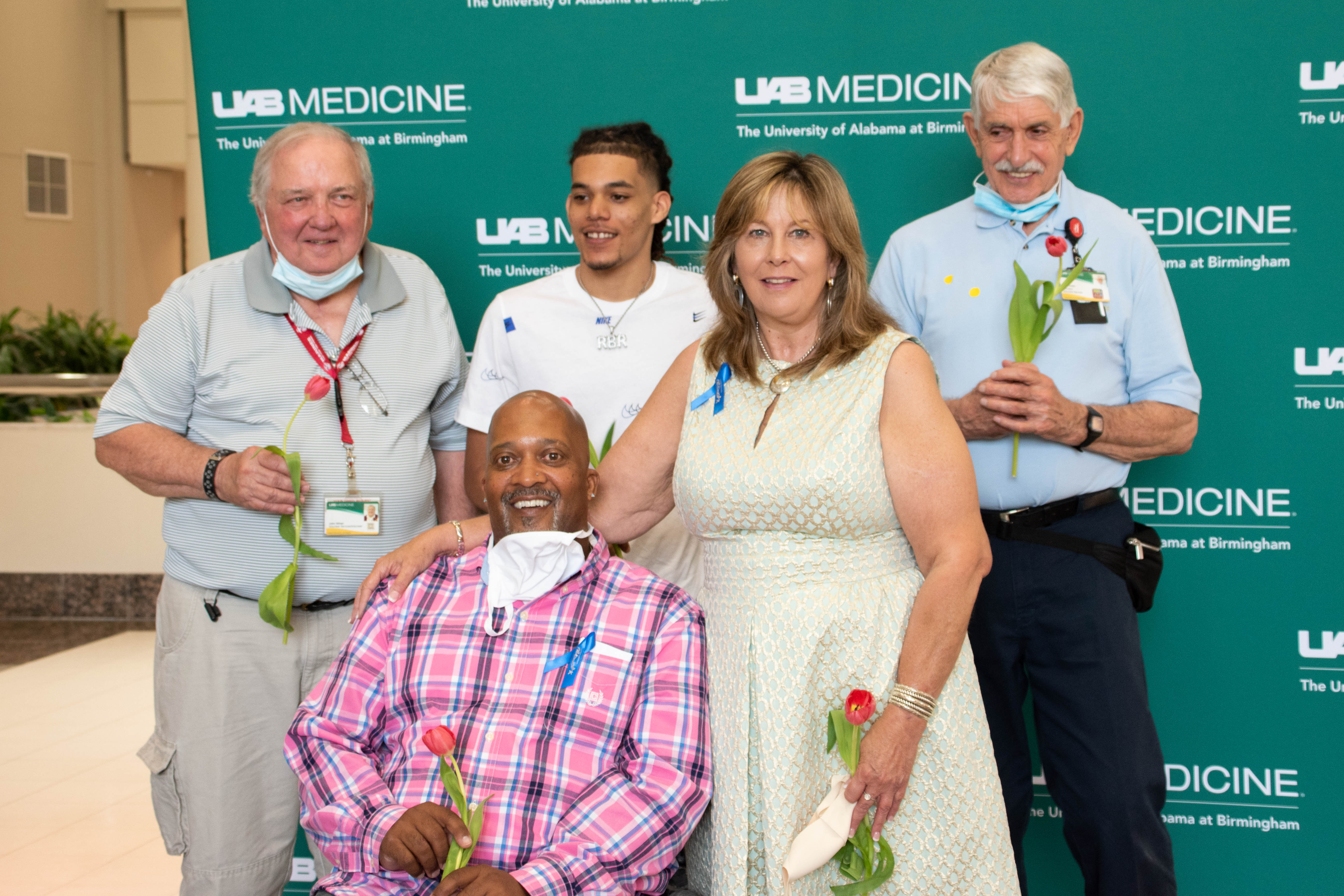
Daryl Coleman
Coleman is shown above, in the pink shirt, at the UAB Trauma Survivors Day event on May 18, 2022.
Daryl Coleman became a trauma survivor in 2014 three days before his birthday after being involved in a car accident on his way from Cleveland, AL to Huntsville. As his car hydroplaned into a ditch, he remembers asking God to let him live and telling him he could take the pain. “Next thing I know, he gave me the pain.” Coleman said. He sustained a spinal cord injury and became paralyzed from the waist down. He remembers his ICU nurses decorating his room for his birthday, and when went to rehab at Spain Rehabilitation Center, he says they didn’t give him a chance to be a weak. His trauma took a toll on his entire family. He initially lacked confidence to do things on his own but over time, he relieved his family of caregiving responsibilities and equipped his car so he could drive again.
Coleman has two tattoos he’s gotten since his accident: “Warriors never give up” and “With pain comes strength.” He wants to share his story and offer hope to other trauma survivors – he recently completed training to be a peer mentor with both the Christopher and Dana Reeve Foundation and the UAB Trauma Survivors Network.
"I want people that have had life changes I can relate to know things get better,” he said.
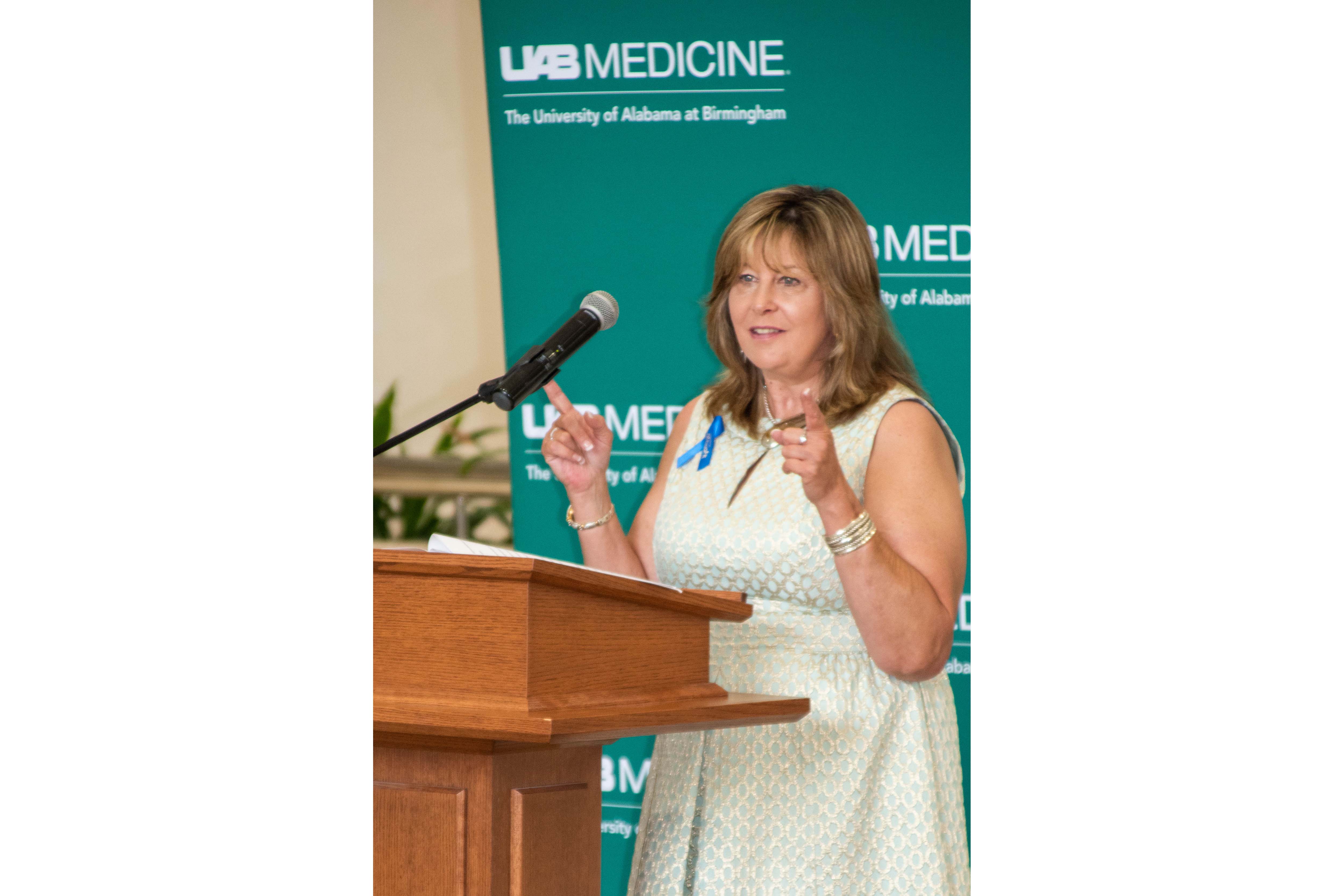
Diane Eubank
Eubank is shown above speaking at the UAB Trauma Survivors Day event on May 18, 2022.
Diane Eubank became a trauma survivor on Christmas Eve, 2018, after an ATV accident in rural Blount County involving a barbed wire fence left her with an internal decapitation - it was only because of her brain stem and spinal cord that her head was still attached to her body. She was initially given a 30% chance to live and was due to her injuries it was thought there was a 98% chance she would be a quadriplegic. After she was airlifted to UAB, a multidisciplinary team sprang into action including trauma surgery, orthopaedic surgery, neurosurgery, oral and maxillofacial surgery, otolaryngology, ophthalmology, and later, therapists at Spain Rehabilitation Center as she learned to talk, walk, and write again.
Today, Eubank is passionate about sharing her story. She is an outspoken advocate for blood donation and has been through training to become a peer mentor with the Trauma Survivors Network, saying she wants to be the person she wished she had had early in her recovery.
“I want to tell people when they’re in their roughest moment and don’t think there’s a tomorrow – there is,” she said.
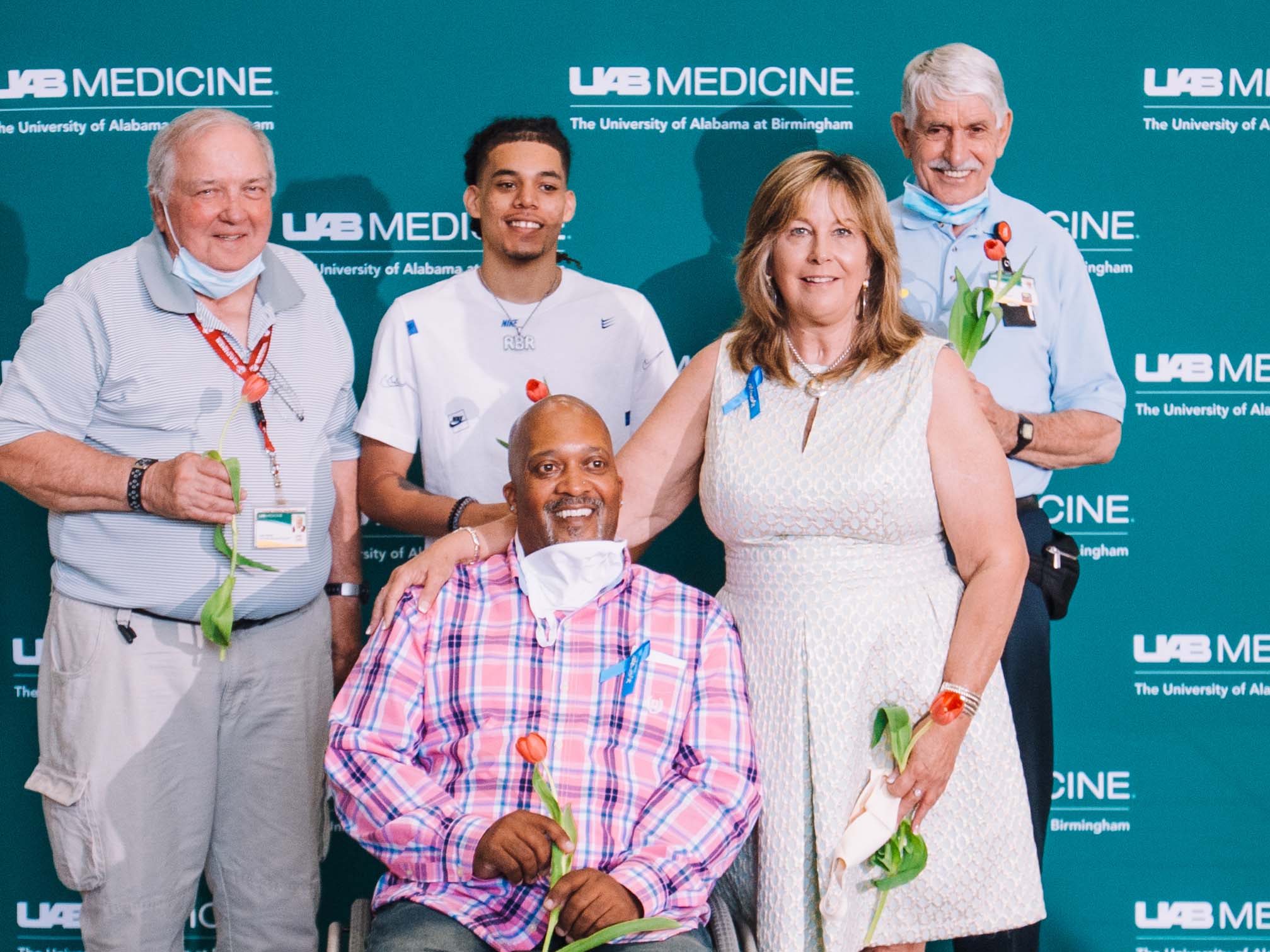
John Hilmer
Hilmer is shown above, far left, at the UAB Trauma Survivors Day event on May 18, 2022.
John Hilmer became a trauma survivor in 2011. As he was watching someone cut a tree down, the tree fell the wrong way and hit a telephone line, which landed on his head and compressed his vertebrae, broke his neck, and split his scalp open. He also sustained a 10% disabling TBI which he jokingly blames mistakes on. He was in the ICU for six weeks, on a respirator and with a collar holding his neck in place. He remembers waking up at 2 a.m. and reciting the one prayer he could remember as a Catholic – the Hail Mary. He made a recovery after months of physical therapy including a stay at Spain Rehabilitation Center.
Just six months after his injury, he was back at UAB – this time as a volunteer. He has served coffee as well as Thanksgiving, Christmas, and Easter meals to families in the ICU waiting room and shared his story of recovery to provide understanding and hope. He has put in 2,425 volunteer hours at UAB. He says volunteers were there for his family when he was in the ICU and it was uncertain whether he would survive.
“That’s why we go back, we’re the lucky ones,” Hilmer said of him and trauma survivor Jerry Jones. “That’s our gift to us – that we can help somebody else.
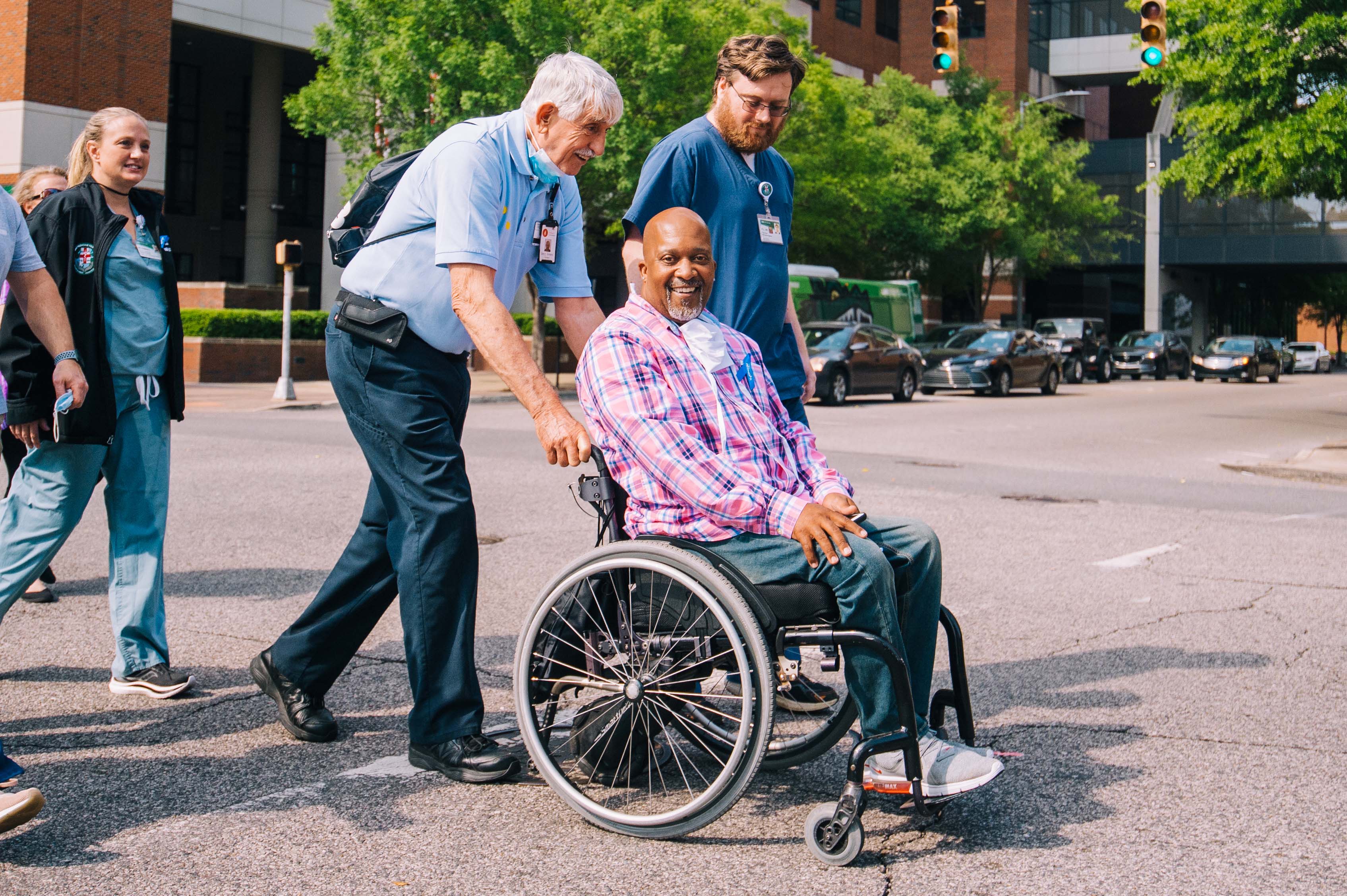
Jerry Jones
Jones is shown doing what he loves - serving others - by pushing fellow trauma survivor Daryl Coleman at the UAB Race to Rebuild event on May 18, 2022.
Jerry Jones became a trauma survivor in 2009 after falling off the top of a 32 foot ladder while cutting down a pine tree. He sustained a concussion, had blood on his brain, broke two teeth and six vertebrae, punctured a lung, and broke his hip, pelvis, and all the ribs on one side of his body. He was in the ICU for six weeks and then had weeks of rehabilitation. He said he had a strong will to get better and wanted to work on his physical therapy 24/7 to get up and get well. At age 77, he still goes to the gym three to four days a week.
Just a year after being a UAB trauma patient, he became a UAB volunteer, and later a volunteer at Children’s Hospital; he has served a combined volunteer 9,500 hours. At UAB, he pushes patients in wheelchairs around the hospital and has helped serve meals to family members of trauma patients in the waiting room. He says working with patients is his ministry. Jones can particularly empathize with other trauma survivors and their family members, but he provides a listening ear to all patients he encounters at UAB.
“Sometimes there are no words,” Jones said. “You’ve got to love them more than you got to talk.”
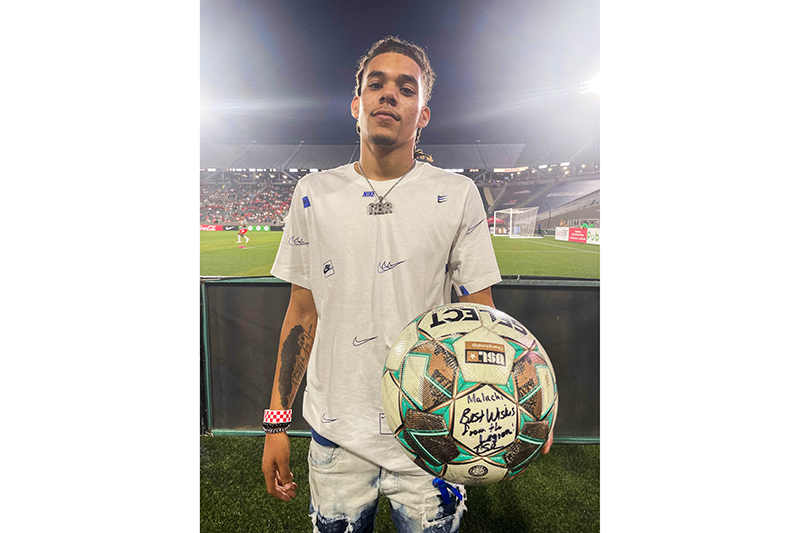
Malachi Teague
Teague is shown above with a signed soccer ball from the Birmingham Legion Football Club. He was recognized on the field at halftime during a Trauma Survivors Day spotlight on May 18, 2022.
Malachi Teague, age 18, became a trauma survivor in December of 2021. He was at a gas station with friends when an altercation he wasn’t involved in broke out – and then a woman pulled out a gun and started shooting. Teague was fleeing the scene when he was shot in the back, through his abdomen. He arrived at UAB two hours after his injury, needing three surgeries and two human bodies worth of blood. It took a multidisciplinary effort involving trauma, TBICU nursing, vascular surgery, nephrology, and the blood bank to care for Teague. His type of injury is normally not survivable, but though he lost a kidney and his spleen, and his liver and pancreas were damaged, and he had 71 staples from his upper chest to his belly button, he’s still here today.
Just five months after his injury, he admits he’s not feeling 100% - but he feels up to doing most things, including activities he loves like playing sports and making music with his brothers and friends. He’s more thoughtful now about where he goes, who he’s with, and what he worries about.
“If I don’t want to deal with something, I’m not going to deal with it – there’s bigger things out there than some of the stuff I’m going through,” he said, with his mom Karen Bishop adding that he’s humble despite facing near-fatal injuries and making an incredible recovery.